Carretera Austral Part 7: Cochrane - Villa O'Higgins
&otOriginally posted to El Cantar de la Lluvia on Monday, March 12, 2007


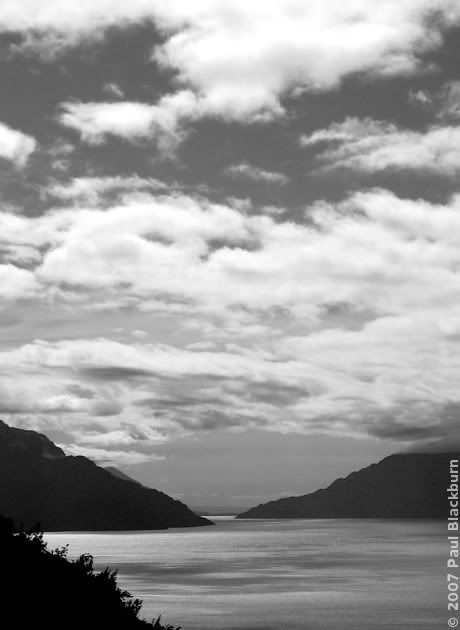
Eventually I reached the lake's outlet. I left the road and rode towards the shore. Before I knew it, I was over the rims in soft, dry sand. I kept that back wheel spinning, and it was only thanks to the ridiculous load on the rack and my frantic frog paddling that I was able to get back onto harder stuff.
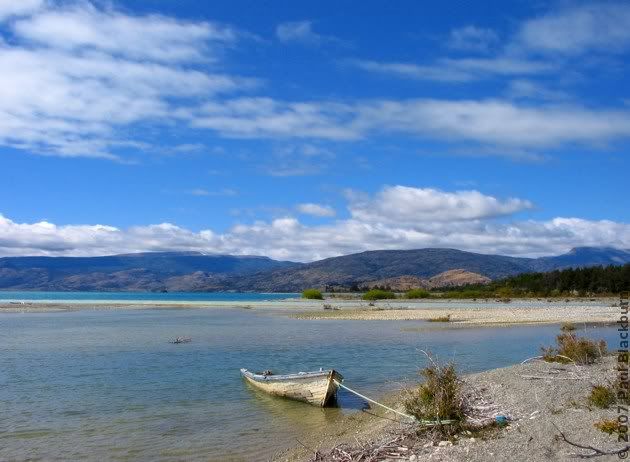
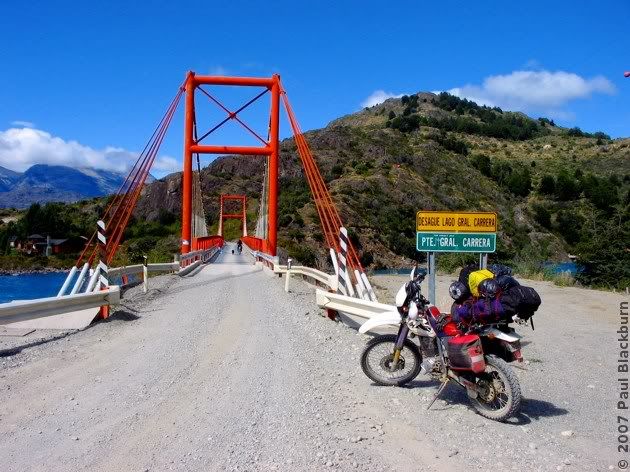
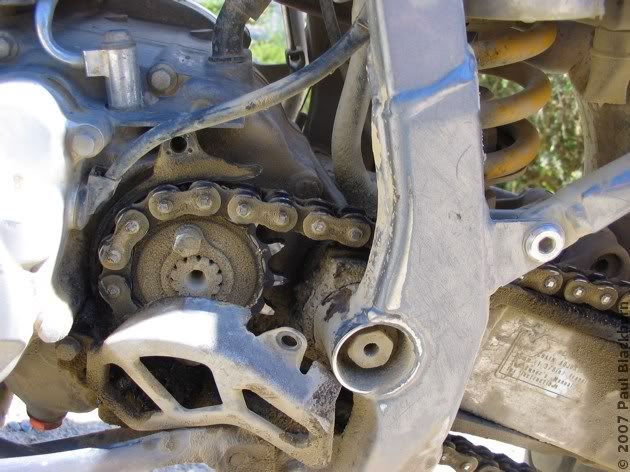


The vegetation is almost like that which lies a few hundred kilometres North of Santiago; the heat and dry air were most familiar and comforting.
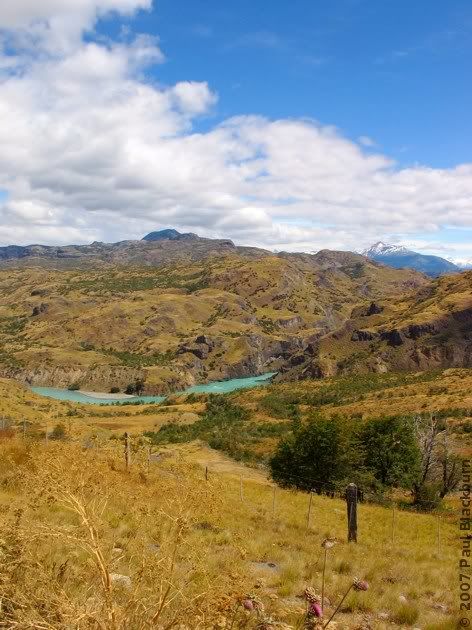
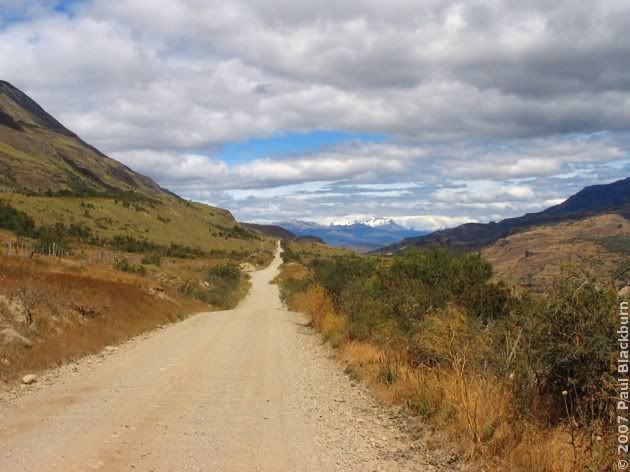

I bought two 5 litre plastic containers, and filled them with fuel. More weight on the bike, more farting around when it was time to pack or unload it. Indeed, allow me to illustrate my point: Going from a completely naked bike, with my luggage all set neatly beside the bike, and myself in street clothes, to a fully packed and ready bike, plus a fully kitted and ready rider took about an hour, sometimes more. A real hour, those real hours that lie hidden behind two fifteen-minute tasks. This was frustrating and tedious, but not all of us can afford nice panniers (and I wanted my bike to be as crash-resistant as possible).


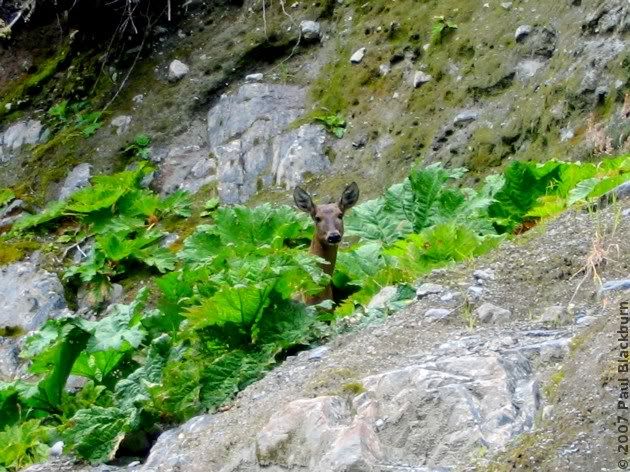
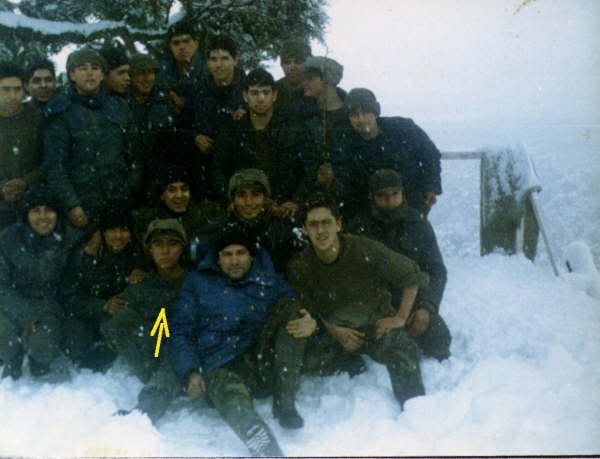
He tells us:
It started to rain. I had to reach Puerto Yungay before 12:00 because if I didn't, I'd miss the ferry to Río Bravo. I stopped, and it took me a few minutes to get the rain suit on. It started to rain harder. It was cold. Mud is almost nonexistent on the Carretera Austral, so I kept up a good speed. And by good speed, with a ferry to catch, you know what I mean.
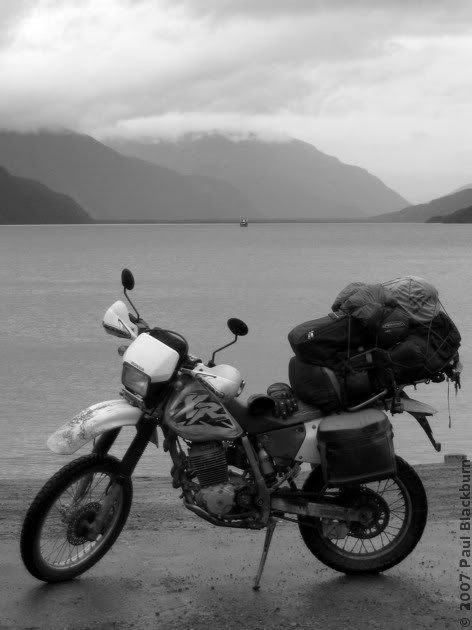
It was raining. There was not a soul in sight. The next ferry left at 18:00. It was 12:11.

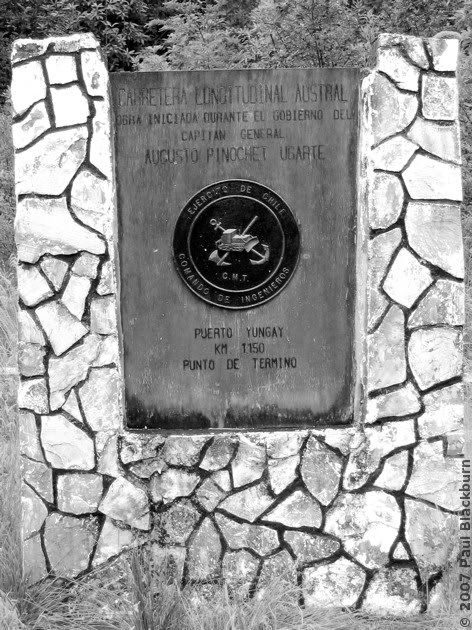
It was cold.

A few hours later, vehicles started arriving. One of them, a pick-up truck, rolled down the window and said hi. They asked me about something. We started chatting. They were forced to rent the pick-up in Coyhaique because their RV had gone bust. Wait... RV? Coyhaique? It was the same couple! I didn't recognize them and they hadn't recognized me. We chatted about many things. He was a retired rally racer, and they had done a few of the more northerly sections of the Carretera Austral sometime in the early nineties.
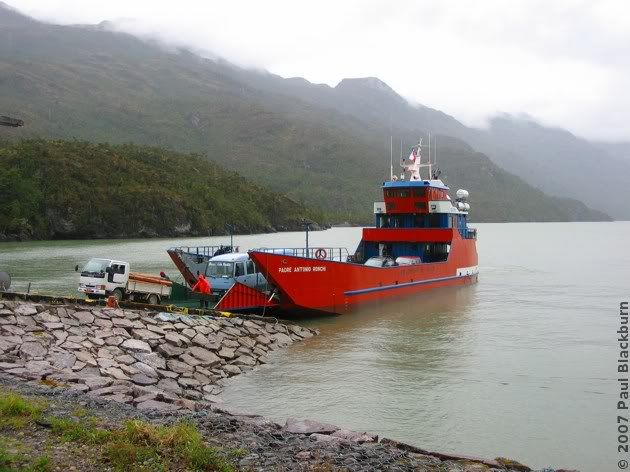
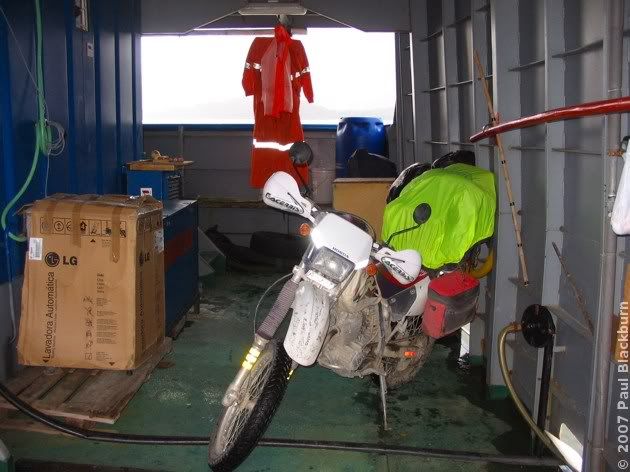

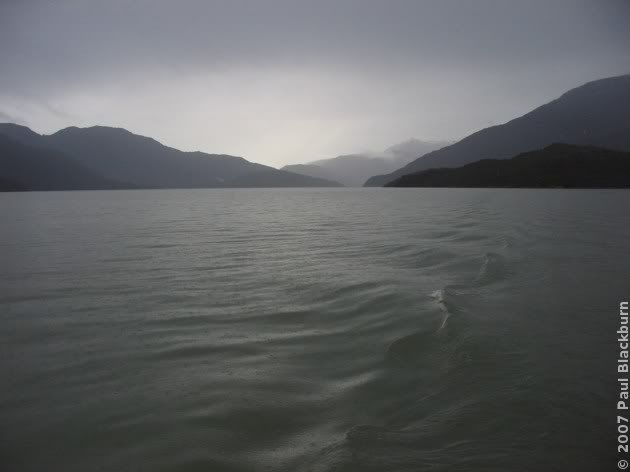
And this is why the ferry got its name:
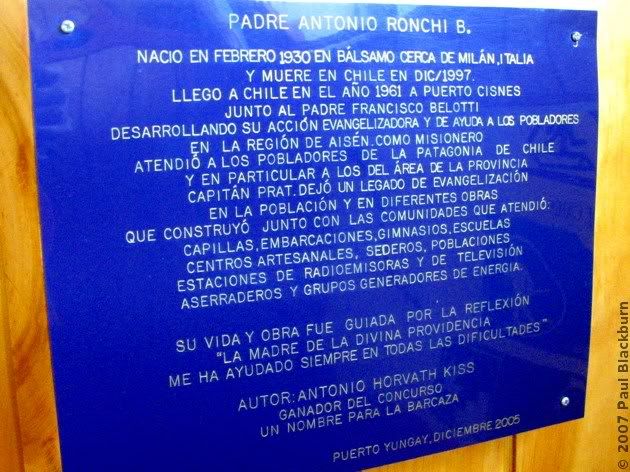
Time to make landfall at Río Bravo. 120 km still to go to Villa O'Higgins, and it was already 19:00.
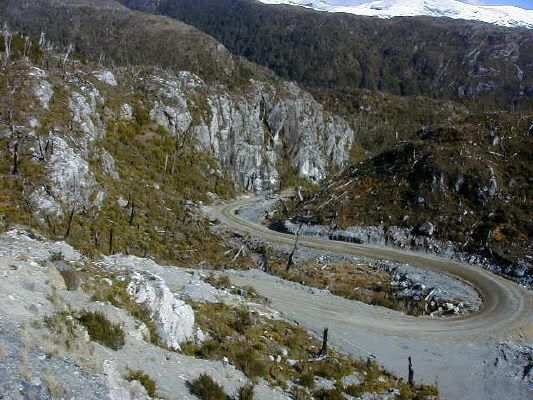
My chain started making an unpleasant sound, barely audible over the engine and road. I hadn't oiled the chain in a while. I had long ago run out of the sticky PJ1 (black label) lubricant I normally used, and I was just using my reserve of 80W90 gear oil. It doesn't attract as much dust and crud as the stickier stuff, but it is washed away almost immediately if there is any water flying around.
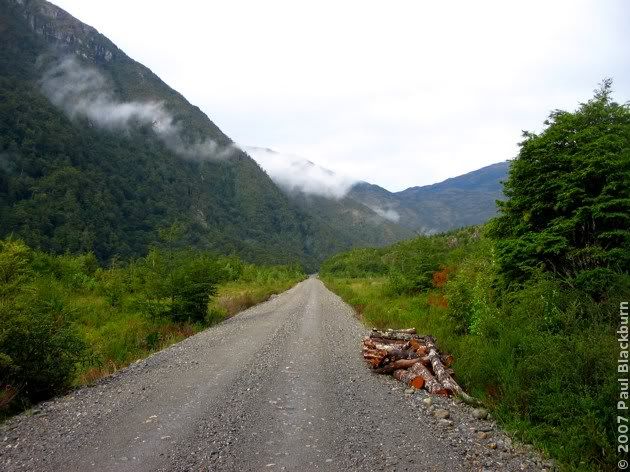
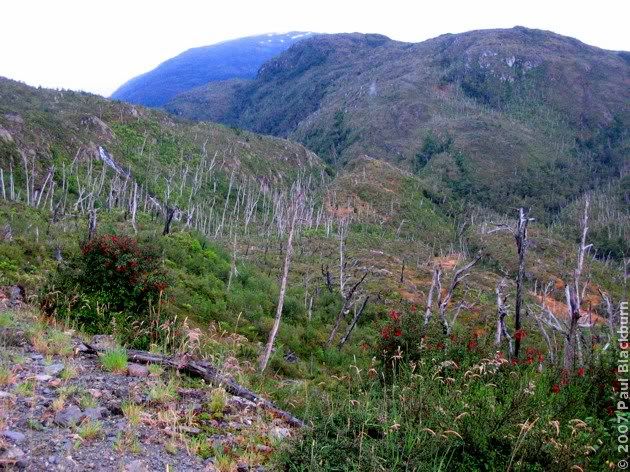
Next Chapter: Villa O'Higgins and the Fiesta Costumbrista
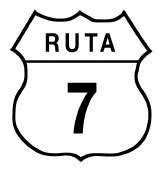 | Days 13-14: Puerto Río Tranquilo -Cochrane - Villa O'Higgins | 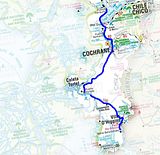 |
Breathe deep; this is a long one.
I woke to the sound of Tom quietly packing his kit for a hike to the Glacier. Today I'd be setting off down South, to Villa O'Higgins. I wouldn't be seeing him again for a while.
We said a short goodbye, as goodbyes always should be, and off I went.
I tried using my foam ear plugs (sanity-preserving on the highway, without a doubt), but every bump and vibration of the dirt road was like a dull and wet sound inside my head, which quickly made my eyes water. Out came the ear plugs.
The Lago General Carrera in its full glory.


The road was dusty and occasionally winding, but it was a thousand times easier during the day.



I passed through Puerto Bertrand, a minute group of houses and pretty residenciales, on the shore of Lake Bertrand.
Several kilometres down the road, I was following the Río Baker, that same incredible turquoise colour that the Lago General Carrera had, thinking about how hot it was (I was in full cold weather gear, anticipating the worst), avoiding large pick-ups coming swaying at me down the middle of the road, driven by rich lunatics, when I noticed something strange about my gear shift pedal.
There was a strange sound coming from down there, and it was hard to shift gears. I looked down as I rode along, and saw this:

The front sprocket cover had come loose. I immediately understood why this was: a few days before leaving Santiago I had stripped the upper bolt's thread. Mea culpa, mea culpa. I parked the bike, rear wheel facing into the steep slope at the side of the road (the only way to park a loaded bike on the entire Carretera Austral), took off the thermal kit and walked some 250 to 300 metres back up the hill, looking for the bolt. Obviously I never found it.
I took the cover clean off, and with it, the steel case saver that went underneath it. Now, if the chain were to break, it would slice through my engine and leave me stranded. Not nice. Anyway, onward we must go.

The road to Cochrane is beautiful.



I rolled in to Cochrane, and checked in at the Residencial Lat 47 Sur. 8000 pesos a night, and a wonderful homely atmosphere. It was just what I needed after Puerto Río Tranquilo (where I managed to completely trash the residencial's bathroom upon attempting a one-leg balancing act to put on my jeans without letting them touch the wet bathroom floor; scratch one curtain rail, shower curtain and lamp/lampshade combo for extra points).
In this series of articles I don't make many specific recommendations, but I do recommend this place. And the owners are very nice.
Checking my mail in Cochrane's cyber café, I received an email saying simply that I had been accepted at the University of New Mexico at Albuquerque. It was a strange feeling. Maybe I'll explain it some day.
I bought two 5 litre plastic containers, and filled them with fuel. More weight on the bike, more farting around when it was time to pack or unload it. Indeed, allow me to illustrate my point: Going from a completely naked bike, with my luggage all set neatly beside the bike, and myself in street clothes, to a fully packed and ready bike, plus a fully kitted and ready rider took about an hour, sometimes more. A real hour, those real hours that lie hidden behind two fifteen-minute tasks. This was frustrating and tedious, but not all of us can afford nice panniers (and I wanted my bike to be as crash-resistant as possible).
That night, I chatted to the residencial's owner as we watched the Festival de la Canción de Viña del Mar, a rather big affair done once a year in the summer. She told me about the low, low levels of crime in Cochrane. People live in a special atmosphere, apparently devoid of the socioeconomic divides that pervade the rest of chilean society. The prevailing feeling is that everyone is there under harsh conditions, and that everyone is doing their part by populating the area, when they could just as easily live in a more accessible area, with a better climate and more opportunities.
I also learned about the bonificaciones the government gives people who work in these areas. We chatted until late, as we watched Tom Jones do his thing for the Festival's audience, sometimes called El Monstruo. More than one well-known contestant has been reduced to tears at the monster's whim.
An early rise, for today I would set off to Villa O'Higgins. As I packed I remembered a conversation we had with Tom, sitting on the beds in our room in Puerto Río Tranquilo, sharing Hermanos Carrera white wine from a box (so bad, yet sweet and delicious to this ignoramus). I wasn't sure if I should go to Villa O'Higgins or not, if I'd have enough petrol to make it, if it was worth it. Camilo had declared that he was happy with his progress so far, and that he was perfectly content to turn back now and carry on up, doing things we missed on the way down. Tom drank from his D'Olbek glass, purchased as an addition to his collection back home, and which would break the next morning after a fall from the bedside table, and said: "I think you'll make it. Yes, I think you'll get to Villa O'Higgins". Sometimes an innocent comment is that grain of sand that tips the scales.

Around Río Vagabundo, the last segment of the Carretera Austral to be completed, I met this huemul, unfortunately now nearly extinct.


As I mentioned, this is the last stretch of the Carretera Austral to be completed by the Cuerpo Militar del Trabajo, in March 1996. There were two CMT teams working on it, edging closer from Puerto Yungay and from the North.
I was extremely surprised to receive a message on the Adach.cl forum from Luis Alberto Cabezas. He told me that he was one of the young lads that worked on this segment of the Carretera Austral. As a matter of fact, here he is:

He tells us:
We worked our fucking asses off. We risked our lives every single day. I secured my rope to the rock and went down on my own. Down on the 80º incline we'd set to work, drilling with the guagua and packing the hole with explosives. We'd then detonate them, and the whole side of the hill would fly off into the opposite hillside, and into the Río Vagabundo, rocks the size of houses.
In March '96 we made our final blast, the one that joined the two ends at Río Vagabundo. We went from here to there, and they came from there to where we were, blasting and smashing mountain rock, 200 metres in one year: that's what was left. And after that last blast, everyone ran across the rubble and met in the middle, met all the other soldiers... that was a historic moment.
A few days later el tata ("grampa", Augusto Pinochet - Ed.) landed in a Puma helicopter. Us 15 soldiers at the Vagabundo —there weren't many of us—, all standing in formation on the top of that mountain. He came and shook our hands, all of us. I still remember his blue eyes. When he asked where I was from, I answered "FROM LA CISTERNA, MI GENERAL!!!!"
From there we went to a celebration in Puerto Yungay, with lambs on the spit. At the ceremony our commander finished it all by saying to el tata, hand on his cap in military salute: "Accomplised; The order you gave twenty years ago, mi general, the order to have the Carretera built. Accomplished". I remember this and my hairs stand on end. You know? "The order you gave twenty years ago is now accomplished, mi General".
I didn't even have time to stop and check my watch. I was just trying to get there as soon as possible.
Finally I reached Puerto Yungay, and as I skidded to a halt at the loading ramp, I could clearly see that I was too late. That dot on the horizon was the ferry.

In the tiny shelter, which can just be seen behind a post, I placed the bike across the opening to cut the wind. It would be a long, long wait.
And hanging over it all: "Obstacles are there to be overcome".

And here's the landmark at the end of the Camino Longitudinal Austral.

It was cold.
I remembered the sheepskin, and made a monoslipper to keep my feet warm.
I read the Turistel from cover to cover. I ate a few things I had brought with me. I had a pee.
Rain. On the small shelter large drops occasionally fall, with a rap of tin. Here, on the lakeshore, there is nobody. The tiny kiosk is closed. Campamento Puerto Yungay lies silent, save for the distant hum of a generator. On the wooden bench beside me: my helmet, my protective gear, the open Turistel, face down. The bike shares the shelter with me: there's just enough room for both of us. It will be a long wait.
I reached Puerto Yungay a few minutes after Padre Antonio Roncci, a Ministerio de Obras Públicas, Dirección de Vialidad ferry set sail. The rain, the boarding ramp, the grey lake, the horizon barely distinguishable. In the distance, a tiny orange dot.

A few hours later, vehicles started arriving. One of them, a pick-up truck, rolled down the window and said hi. They asked me about something. We started chatting. They were forced to rent the pick-up in Coyhaique because their RV had gone bust. Wait... RV? Coyhaique? It was the same couple! I didn't recognize them and they hadn't recognized me. We chatted about many things. He was a retired rally racer, and they had done a few of the more northerly sections of the Carretera Austral sometime in the early nineties.
After a very long wait, it was time to board. The ferry is free.

At times it rained, at times it didn't. I stowed the bike as best as possible, leaning it against a wall. The high centre of gravity and long suspension were a recipe for disaster.


Did you know that when it rains on a lake, some drops land on the surface and stay there, like tiny bright pearls? Well, I didn't. And that's what I'm seeing now. The six hours of waiting now feel neither too long nor too short.
I think of the pride that the CMT soldiers must feel. I see the cold jungle on the hillsides and I think what a penetration road might look like, hugging the hill's folds like a long, lazy snake.
The faintest hint of sun comes through the clouds; enough to cast hollow shadows on my paper. It smells like churrasco. I'm hungry.

And this is why the ferry got its name:
PADRE ANTONIO RONCHI B.
Born February 1930 in Bálsamo near Milano, Italy,
Died in Chile, December 1997.
Came to Chile in 1961, to Puerto Cisnes along with Father Francisco Belotti, developing his evangelizing mission and his help for the people of the Region of Aysén. As a missionary he helped the people of Chilean Patagonia and in particular those of the Capitán Prat Province. He left a legacy of evangelization and public works in the communities he helped: chapels, ships, gymnasiums, schools, art centers, paths, settlements, radio and television stations, wood mills and electrical generating stations.
His life and work were guided by the phrase "The mother of the Divine Providence has helped me in all difficulties".
Author: Antonio Horvath Kiss
Winner of the contest "Name the Ferry"
Puerto Yungay, December 2005

Time to make landfall at Río Bravo. 120 km still to go to Villa O'Higgins, and it was already 19:00.
A short while later I reached a steep climb (photo from vialidad.cl)

My chain started making an unpleasant sound, barely audible over the engine and road. I hadn't oiled the chain in a while. I had long ago run out of the sticky PJ1 (black label) lubricant I normally used, and I was just using my reserve of 80W90 gear oil. It doesn't attract as much dust and crud as the stickier stuff, but it is washed away almost immediately if there is any water flying around.
I stopped, dismounted, and applied the last of the sticky stuff, plus some drops of 80W90 oil with the syringe. That cost me another 15 minutes.
Somewhere along the way I was suddenly hit by doubts about my fuel calculations, and started riding in the most economical fashion I could manage. This also happened to be extremely slow.

The last pic that day, well into the sunset.

I got to Villa O'Higgins around 22:30. I rode around the tiny town in a daze, looking at the very spaced-out houses, the empty lots, the regular grid, feeling happy to have got here at last. I was cold and tired.
I searched for lodging, but nothing caught my fancy. One I did like was closed, no signs of life. I asked at a general store. No, no cabins, but let me call a friend. The thing is, she said, that everyone's full up for the fiesta costumbrista.
Fiesta costumbrista? Well now that sounds interesting.
The friend she called turned out to be the same person I questioned on the street not five minutes ago. She offered me a room at 5000 pesos a night, and I accepted, a little uneasy at the way this might turn out.
The house was quite new, and surprisingly comfortable. Ample, finally a ceiling that didn't threaten my head constantly, a large bathroom, a kitchen and living room area. It was certainly a nice surprise.
And with that, I flopped into bed, exhausted.
Next Chapter: Villa O'Higgins and the Fiesta Costumbrista
Labels: carreteraaustral, rides, trips

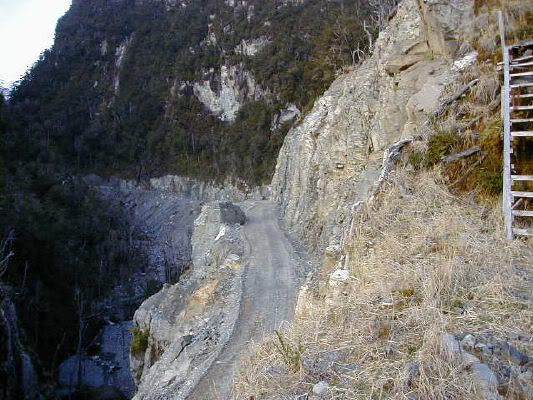
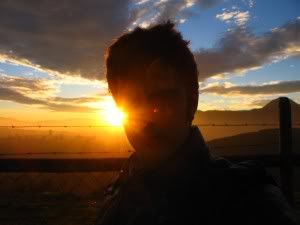
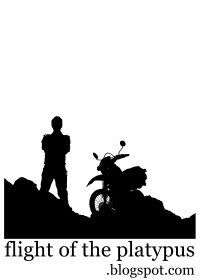

 The Lagoons of the Santuario de la Naturaleza 2: Laguna Los Ángeles
The Lagoons of the Santuario de la Naturaleza 2: Laguna Los Ángeles Race Day At Leyda 4
Race Day At Leyda 4 El Tabo and the Central Hidroeléctrica El Sauce
El Tabo and the Central Hidroeléctrica El Sauce Exploring The Hills Around Lampa
Exploring The Hills Around Lampa A Different Route To Baños De Colina
A Different Route To Baños De Colina The Mines of the Cuesta La Dormida
The Mines of the Cuesta La Dormida The Frozen Lagoons of the Santuario de la Naturaleza
The Frozen Lagoons of the Santuario de la Naturaleza Second Mass Demonstration "For A Fair Tag"
Second Mass Demonstration "For A Fair Tag" First Mass Demonstration Against The 'Tag'
First Mass Demonstration Against The 'Tag' Enduro In Lagunillas
Enduro In Lagunillas Embalse El Yeso and Termas Del Plomo
Embalse El Yeso and Termas Del Plomo Ride To Peñuelas
Ride To Peñuelas Cerro Chena
Cerro Chena Race Day at Leyda 3
Race Day at Leyda 3 Baños de Colina 2
Baños de Colina 2 Carretera Austral: Epilogue
Carretera Austral: Epilogue The Little Giant and Termas del Plomo
The Little Giant and Termas del Plomo Back on Two Wheels
Back on Two Wheels 2006 Photographic Retrospective
2006 Photographic Retrospective Race Day At Leyda 2
Race Day At Leyda 2  Quantum Optics III in Pucón
Quantum Optics III in Pucón Meseta In Chicureo
Meseta In Chicureo Pick Up Your Beer Bottle And Fuck Off
Pick Up Your Beer Bottle And Fuck Off  Planes And Hills
Planes And Hills Cut-Off Road
Cut-Off Road Lagunillas
Lagunillas Laguna Verde 2
Laguna Verde 2 Ride To Anywhere But Aculeo
Ride To Anywhere But Aculeo Cerro El Roble, Second Attempt
Cerro El Roble, Second Attempt Baños De Colina
Baños De Colina Some Walk On Water...
Some Walk On Water... Race Day At Leyda
Race Day At Leyda Almost Cerro El Roble
Almost Cerro El Roble Off To Curacaví with Andrés
Off To Curacaví with Andrés La Serena, Part 3: Back To Santiago
La Serena, Part 3: Back To Santiago  A Bull, Two Cows and a Chilean Fox
A Bull, Two Cows and a Chilean Fox Escape To Cuesta La Dormida
Escape To Cuesta La Dormida Valve Adjustment
Valve Adjustment La Serena, Part 2B: Valle Del Elqui
La Serena, Part 2B: Valle Del Elqui La Serena, Part 2A: Coquimbo and La Recova
La Serena, Part 2A: Coquimbo and La Recova Mud And Pine Trees
Mud And Pine Trees La Serena, Part 1
La Serena, Part 1 Pimp My Exhaust
Pimp My Exhaust Ride To Laguna Verde
Ride To Laguna Verde Ride To La Mina
Ride To La Mina Ride To Termas El Plomo
Ride To Termas El Plomo Camping in Colliguay
Camping in Colliguay Ride To Portillo
Ride To Portillo Ride To Olmué and Con Con
Ride To Olmué and Con Con Siete Tazas
Siete Tazas Watching The Departure Of The Day That Brought Me Here
Watching The Departure Of The Day That Brought Me Here Buenos Aires Motorbikes
Buenos Aires Motorbikes Ride to Talca with the Adach Group
Ride to Talca with the Adach Group Las Trancas '05
Las Trancas '05 Towers and Hills
Towers and Hills María Pinto, Melipilla, Aculeo
María Pinto, Melipilla, Aculeo Me and my Carb
Me and my Carb




0 Comments:
Post a Comment
<< Home